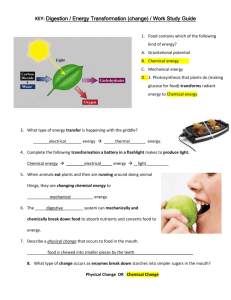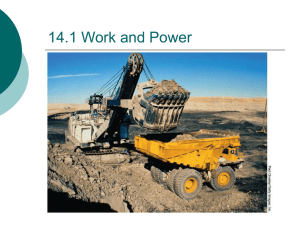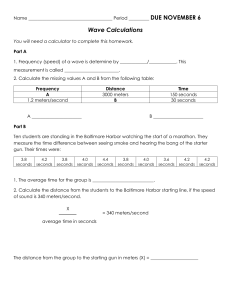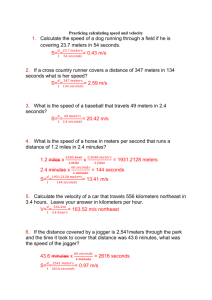energy - New Haven Science
advertisement
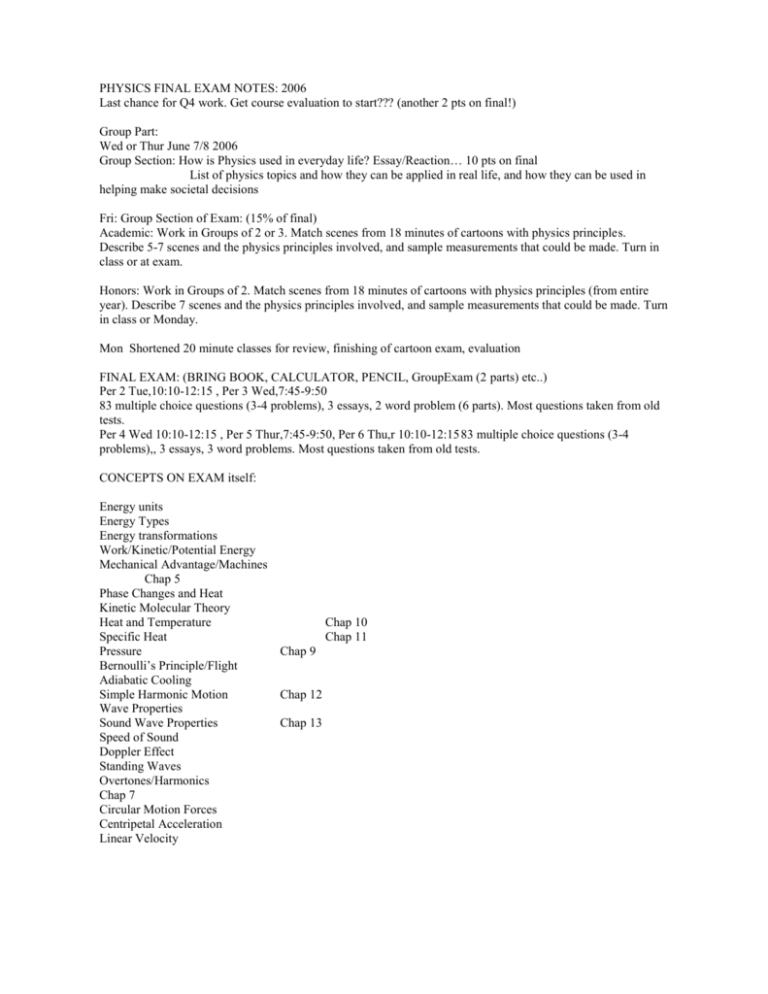
PHYSICS FINAL EXAM NOTES: 2006 Last chance for Q4 work. Get course evaluation to start??? (another 2 pts on final!) Group Part: Wed or Thur June 7/8 2006 Group Section: How is Physics used in everyday life? Essay/Reaction… 10 pts on final List of physics topics and how they can be applied in real life, and how they can be used in helping make societal decisions Fri: Group Section of Exam: (15% of final) Academic: Work in Groups of 2 or 3. Match scenes from 18 minutes of cartoons with physics principles. Describe 5-7 scenes and the physics principles involved, and sample measurements that could be made. Turn in class or at exam. Honors: Work in Groups of 2. Match scenes from 18 minutes of cartoons with physics principles (from entire year). Describe 7 scenes and the physics principles involved, and sample measurements that could be made. Turn in class or Monday. Mon Shortened 20 minute classes for review, finishing of cartoon exam, evaluation FINAL EXAM: (BRING BOOK, CALCULATOR, PENCIL, GroupExam (2 parts) etc..) Per 2 Tue,10:10-12:15 , Per 3 Wed,7:45-9:50 83 multiple choice questions (3-4 problems), 3 essays, 2 word problem (6 parts). Most questions taken from old tests. Per 4 Wed 10:10-12:15 , Per 5 Thur,7:45-9:50, Per 6 Thu,r 10:10-12:15 83 multiple choice questions (3-4 problems),, 3 essays, 3 word problems. Most questions taken from old tests. CONCEPTS ON EXAM itself: Energy units Energy Types Energy transformations Work/Kinetic/Potential Energy Mechanical Advantage/Machines Chap 5 Phase Changes and Heat Kinetic Molecular Theory Heat and Temperature Specific Heat Pressure Bernoulli’s Principle/Flight Adiabatic Cooling Simple Harmonic Motion Wave Properties Sound Wave Properties Speed of Sound Doppler Effect Standing Waves Overtones/Harmonics Chap 7 Circular Motion Forces Centripetal Acceleration Linear Velocity Chap 10 Chap 11 Chap 9 Chap 12 Chap 13 EXAMPLES OF ESSAY QUESTIONS AND WORD PROBLEMS FROM SEMESTER TWO TESTS: Imagine coal burning in a power plant, which heats up water, to create steam to turn a turbine, to turn a coil of wire near a magnet, which generates electricity, which travels to your house. You drive home, press a battery operated infrared remote, which causes the garage door motor to turn, which lifts up the garage door, compressing the spring.List all the possible energy changes from start to finish in this device, and identify where energy might be lost along the way. Sketch a diagram if you need to. ------------A ball is pulled back on a elastic string 5 cm (=.05 m)with 10 Newtons of force. If there is no friction, and the ball has a mass of 2 kg, how high will it go? ---If you use a machine to increase output force, what factor would have to be sacrificed? Give an example? ----A girl pushes a box that has a mass of 65 kg up an incline. If the girl exerts a force of 150 N along the incline, what is the mechanical advantage of the incline? -----A force of 1250 N is needed to move a crate weighing 3470 N up a ramp that is 5.21 m long. If the elevated end of the ramp is 0.750 m high, what is the efficiency of the ramp? -----There is a compound machine that has a person pulling up a three string pulley, which pulls up a 2:1 lever, which pulls down a string, which pulls up a weight moving up a ramp. Sketch this: Explain/show how you would get the ideal mechanical advantage of this compund machine. Explain where mechanical energy might be lost. Use this as an example to explain why we should or shouldn't use complex machines to do simple tasks. ---------A bouncy ball is dropped towards the earth... How is energy conserved: on the way down, when it hits, and after it bounces up? Sketch a graph of what the three types of energy would look like over time. --------------A still person with a mass of 140 kilogram catches a 10 kilogram ball going 20 meters/second, which causes him to roll down a hill that is 3 meters high holding the ball at 1.5 m/s What is the total energy before the collision?What is the total energy after the collision? -----If they are on the top of a 3 meter tall hill, what is the velocity at the bottom of the hill? Explain why you might want to wire your house using parallel circuits, not series. ---What is the end result of the second law of thermodynamics if the whole universe is one connected system? Explain ---A flat container holds 200 g of water. Over a 10 min period, 1.5 g of water evaporates from the surface. What is the approximate temperature change of the remaining 198.5 g of water? ----If 4 kilograms of -2 degree ice are dropped from 50, 000 meters, hits the ground and changes entirely to water, what is the final temperature of the water? ---4 grams of aluminum at 50 degrees Celsius, with a specific heat of 900 are mixed with 20 grams of water at 32 degrees Celsius. Calculate the equilibrium temperature. -----A 12 Volt battery is set in a circuit in parallel with a 40 ohm and 30 ohm resistor, then to a light bulb. Draw a picture of the working circuit. Calculate the current and power through the bulb. ------A pitcher of iced tea is made by adding ice to 1.8 kg of hot tea (water) with an initial temperature of 80.0°C. How many kilograms of ice, which has an initial temperature of -1.0°C, are required to bring the mixture to 10.0°C? ---------------How much faster does the air on top of a 50 kg glider that has a surface area of 20 meters squared have to move in order to lift it? What are the four forces acting on it? What does the force of lift have to be at least equal to? What pressure difference is this? What velocity difference (for air) is this? --Explain how Bernoulli’s principle can be thought of as restating conservation of energy ---I make a sound at a frequency of 500 Hz and note that the echo returns to me 10 seconds later from a wall 1500 meters away. What is the wavelength of the sound? ---Explain with word, pictures, math.... how an object moving around a circle is an example of simple harmonic motion and could create a wave. Make certain to label your drawing. ----If you slosh the water back and forth in a bathtub at the correct frequency, the water rises first at one end and then at the other. Suppose you can make a standing wave in a 150-cm-long tub with a frequency of 0.30 Hz. Draw this (hint, label the crest, equilibrium and trough), then answer What is the velocity of the water wave? ---------------A Physics teacher swings a cup of water around his head with a 4 meter long string. What is the centripetal acceleration needed to make sure that the water doesn’t fall out? What is the minimum speed at which he must swing it? What is the period of his swing? --------------------A tuning fork with a frequency of 400 Hz is held above an CLOSED PIPE air column. If the air temperature is 15 degree C, what is the wavelength & frequency of the fundamental and the first harmonic overtone note? Draw a picture of the waves in the pipe, then sketch how they would appear together (the resultant waveform). ___________________ **If a train 50 meters makes a 1000 Hz whistle (closed pipe) with 31.4 Watts of power, and is coming towards you at 80 m/s…. What is the note that you hear, and how loud is it? (Show work!!!) _________________________________________________ How can beats and resonance be used to find out if a guitar is in tune? _________________________________________________ Describe how air vibrating makes musical sound waves in an instrument like a trumpet. Be sure to use wave vocabulary words such as resonance, harmonics, etc… PHYSICS FINAL EXAM D= ViT + 1/2 AT2 Vf2= Vi2 + 2AD Formula Sheet, pg 1 of 4 A=∆V ∆T F= mA ENERGY Power in Watts = Work/Time Work (Joules)= Force (N) * Distance (m)= ∆ Mechanical Energy KE= 1/2*M* V^2 KE= Kinetic Energy in Joules PE= M*g*h, g= 9.8 m/sec^2 or Weight (N)= Force of Gravity= mg PE =Potential Energy in Joules or PE = 1/2*K*x^2 for a spring, Force(N) =kx (x in meters pulled back from equilibrium CONSERVATION OF ENERGY: ∆E =∆E KE + EPE + PE + Q (heat) + Work stays constant --------------------------------------------------------------------------MACHINES: Actual Mechanical Advantage always= Resistance Force out Effort Force in Ideal Mechanical Advantage= Dist of Effort Dist of Resistance for lever:IMA= effort arm/resis arm pulley IMA=#strings up, ramp IMA= length/height, wheel IMA= wheel/axle Efficiency = AMA/IMA or Work out /Work In ----------------------------------------------------- ELECTRICITY: Power (Watts) = Energy (Joules)/Time (sec) Power(Watts) = Current(Amps) * Voltage (Volts) Voltage (Volts) = Current (Amps) * Resistance (Ohms) Voltage (Volts) = Energy (Joules)/Charge (Coulombs) -1 Coulomb of Charge = 6.2 * 1018 electrons Electric Force is proportional to Charges/Dis2 Electric Field is Force/Charge Series Circuits: Rtot = R1 + R2 ….. Parallel Circuits: V1=V2, 1/Rtot = 1/R1 + 1/R2 …… ---------D= ViT + 1/2 AT2 Vf2= Vi2 + 2AD A=∆V /∆T -------------------------------------------CONSERVATION OF ENERGY: ∆Q + KE + PE + ∆W = ∆Q + KE + PE + ∆W KE= ½ M V2 KE= Kinetic Energy in Joules GPE= M*g*h, g= 9.8 m/sec2 PE =Potential Energy in Joules EPE = ½ k x2 k is spring constant k=F/x •∆Work (Joules)= Force (N) * ∆Distance (m) = Pressure (Pa) * ∆ Volume (meters cubed) HEAT ∆Q Two substances in contact: ∆Q=∆Q for thermal equilibrium -Increasing/decreasing temperature without changing phase: (C is the specific heat of a substance changing temperature) ∆Q=m*C*∆T -Changing phase: ∆Q=m*Hf for melting/freezing, ∆Q=m*Hv for vaporizing/condensing (Hf and Hv are the heat of fusion and the heat of vaporization for a substance changing phase) Thermodynamics Law 1 Conservation of Energy Heat Added = Internal Energy(Temp) + Work done ∆Q = ∆U + ∆Work Efficiency = (Thot-Tcold)/Thot (law 2) T=Temperature in Kelvin Entropy or Order to Chaos, 2nd law WATER: ICE: °K WATER: C=2090 J/Kg °K, Liquid C=4187 J/Kg °K, Hf=335, 000 J/kg STEAM C=2020 J/Kg Hv=2,260,000 J/Kg Person: C= 3470 J/Kg °K, C for liquid or gas person=1674 J/Kg °K boils at 1700 degrees Celsius Hf=277633 J/Kg, Hv=1872988 J/Kg, Other conversions: Density of Water= 1 gram per milliliter=1000 kilograms per cubic meter 1000 grams= 1 kilogram, 1 kilogram=.001 grams degrees Celsius= degrees Kelvin- 273 1 Kilocalorie= 1 Calorie = 1000 calories = 4187 Joules 1 Kilowatt Hour = 861 Calories PRESSURE water has the density of 1 gram per ml, 1 Kg per Liter, 1000 kg per cubic meter Normal sea level pressure is 101,300 Pascals (SI Unit)or 101.3 kiloPascals, or 101,300 Newtons per square meter... also, 1 atmosphere, 14.7 pounds per square inch, 998 Torr, o) 998 millibars, 29.2 inches of mercury, 10.3 meters of water, etc... Weight (submerged)= Weight - Weight of Fluid Displaced (Archimedes) V= 1 cubic meter= 1000 Liters = 1,000,000 cubic centimeters A=1 square meter = 10000 square centimeters M=1 kilogram = 1000 grams Volume = Area times Distance F net =Weight (submerged)= Weight - Weight of Fluid Displaced (Archimedes) = Dens (Vol) - Dens(fluid)*Volume (fluid) W=Weight (N)=Mass(Kg) times g F=(Force = Mass times Acceleration) (Newton) D= Density = Mass (kg)/Volume (cubic meters), D=M/V, in kg/m3 Mass = Density times Volume, M=DV Volume=Mass /Density, or V=M/D Pressure (Pa) = Force (N)/ Area (square meters) , P=F/A Force (N) = Pressure (Pa) times Area (square meters) F=PA Pressure is constant in a static fluid (Pascal) F1 /A1 = F2/A2 for flowing fluids, rate of flow (Volume/time) is constant so that velocity(m/s) times Area (square meters) = velocity (m/s) times Area vA=vA Pressure(Pa) + 1/2* Density *(velocity squared) + Density* g *height is same as conservation of energy (times volume) , or Bernoulli’s equation for fluids, P + 1/2D (v)2 + Dgh = P + 1/2D(v)2 + Dgh (Bernoulli) (For no motion, P=P1 + Dgh, For no height change, and starting from 0 speed, P=P+.5Dv2, ) Simple Harmonic Oscillators/Motion and Angular/Circular Motion /Waves/SOUND T 2 Pendulum Period= T 2 L g L=Length in meters m k Spring: Period= where k is the spring constant k= Force/distance, m=mass inKg, k=spring constant WAVES: Period T =1/ƒ V=D/T=f*WL v = f * WL for any wave Period= T= Seconds per Wave or Seconds per Revolution WAVES/Circular Motion Period=T=1/ƒ V=ƒ WL for any wave, or V=ƒ/T ƒ is frequency in waves/sec or Hertz, WL is wavelength in meters or ƒ is frequency in revolutions/sec or Hertz, WL is circumference=2pi r in meters V= Linear Velocity in meters per second, or V=2pi r/T, V=ƒ 2 pi r V=w/r , w is angular velocity in radians per sec (360°=2pi radians) C=WL=2pi r Centripetal Acceleration A=V2/r Sound WAVES: Period=1/ƒ V=ƒ *WL for any wave Sound Open Pipe WL=2 L ƒ, 2ƒ, 3ƒ, etc. Closed Pipe WL=4 L ƒ, 3ƒ, 5ƒ etc... Standing Waves ƒ = nV/ 2L for strings, open pipes (n = number of antinodes) n=1 is the fundamental ƒ = nV/ 4L for closed pipes (n = number of antinodes) Beats: ƒ=ƒ1-ƒ2 V=331 m/s + .6 * Temp for Sound Doppler Shift f=f0 (Vsnd + Vdetector)/(Vsnd-Vsrce) 10-12 Watts/m2 = 0 decibels 10-11 Watts/m2 = 10 decibels = twice as loud Intensity = Power/Area ( Area of a sphere = 4πr2 )
